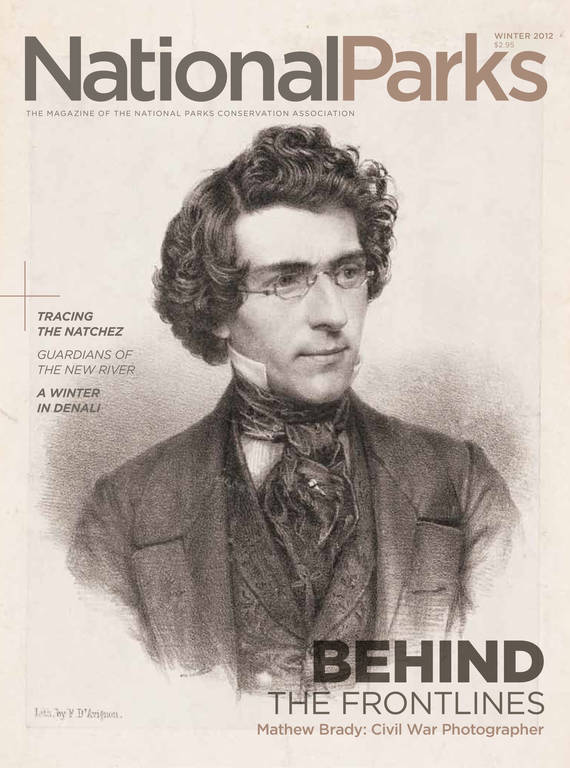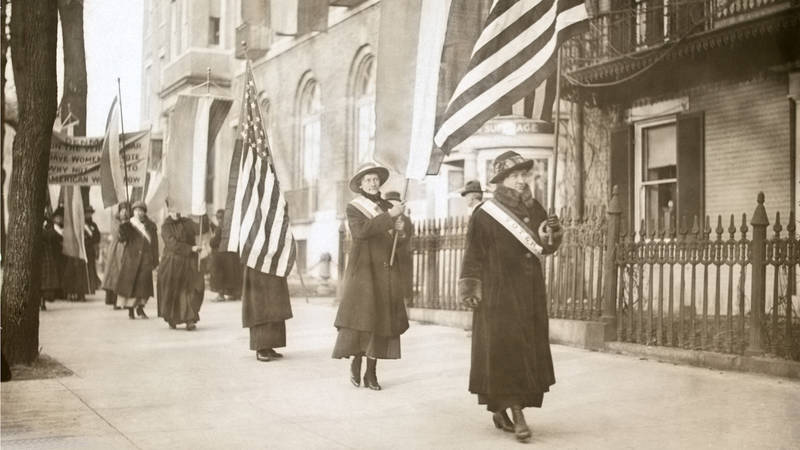Winter 2012
The Wright Stuff
The origins of flight are revealed at Wright Brothers National Memorial.
On the morning of December 17, 1903 the sky dawned a pallid gray, temperatures hovered below freezing, and fierce winds battered North Carolina’s Outer Banks—conditions that might send many back to bed. Not Wilbur and Orville Wright. The brothers rose and dressed in suits, stiff collared shirts, ties, and caps. They rolled their flying machine—a homemade apparatus of spruce, ash, and muslin—to a track. They shook hands, and Orville climbed aboard.
“Wilbur tried to pump up the witnesses to get them to jump up and down and hoot and holler to encourage Orville,” says Darrell Collins, the historian at Wright Brothers National Memorial. “But once the flight took place, they were stunned and were silenced.” Five witnesses watched as the plane clattered 40 feet down the track, rose, dipped, then soared for 12 seconds—120 feet in all.
It was the first time humans had flown under their own power, without losing speed or altitude. That day, the brothers’ stoicism belied the fact that they’d accomplished what humans had been dreaming of for millennia. The telegram Orville sent home to their father said little more than this: “Success four flights… inform press home Christmas.”
Wilbur and Orville Wright may not have seemed obvious candidates to accomplish the first human flight. The brothers grew from humble beginnings in Dayton, Ohio, where they ran a bicycle shop on West Third Street. (The Dayton Aviation Heritage National Historical Park preserves this and other Wright landmarks.) Neither ever married, graduated from high school, or left the family home, but together they managed to solve the enigmas of lift, propulsion, and control that had eluded more famous and moneyed inventors like the Smithsonian’s Samuel Langley and German Otto Lilienthal. The Wrights’ story is the stuff of legend: An underdog triumphs with the simple American values of hard work, ingenuity, and perseverance.
The notion of flight first captivated Wilbur and Orville Wright through an unlikely prop: a spinning toy that could fly up to 50 feet in the air, which their father brought home as a gift in 1878 when they were about 11 and 7 years old. After founding the Wright Cycle Company in 1892, they set their practical minds to the problem of flight and their extra cash to financing it.
“From childhood they were inquisitive and interested in mechanical equipment and tools,” says Collins. “They were very humble but they were also very self-confident, very determined show their invention to the world.” Both men were small in stature—no more than 5’7” and 140 pounds—with gray-blue eyes. Wilbur was the visionary and an eloquent speaker; Orville was a reserved man of great practicality. Perhaps one of their best assets, however, was their ability to collaborate.
One of the Wrights’ major conundrums, which no other inventors had come close to solving, was lateral control. After studying birds in flight and, one day, idly twisting a bicycle-tube box, Wilbur had a eureka moment: By allowing one wing to flex in the opposite direction of the other, the aircraft would be stabilized. After testing the design with success on a five-foot biplane kite, the brothers realized they were on to something and needed to find a better place to test their contraptions.
Enter Kitty Hawk, the site that is now home to the Wright Brothers National Memorial. This series of sand dunes, free of obstructions and blessed with reliable winds, made the perfect proving grounds, even softening anticipated crash landings. After a few promising glider flights off the Kill Devil Hills in October 1900, the Wrights returned to test their designs every year until they knew they had a vehicle they could control. After their first flight on that day in December 1903, the Wrights flew three more times until Wilbur covered an astounding 852 feet in 59 seconds. With a mere $1,200, they had beaten out inventors like Langley, who had squandered some $75,000 of government and private money.
“We were astonished to learn what an immense amount of time and money had been expended in futile attempts to solve the problem of human flight,” Wilbur wrote years later. “Contrary to our previous impression, we found that men of the very highest standing in the professions of science and invention had attempted the problem.”

National Parks
You can read this and other stories about history, nature, culture, art, conservation, travel, science and more in National Parks magazine. Your tax-deductible membership donation of $25 or more entitles…
See more ›Back then, the Outer Banks might have seemed bleak to an outsider oblivious of newfangled flying machines. Now, it is a favorite vacation destination. Windsurfers harness the breezes, sun seekers build sand castles and swim in the sea, and aviation buffs, families, and school groups make the pilgrimage to the Wright Brothers National Memorial, where they can see full-scale reproductions of the 1902 glider and 1903 machine and the engine crankcase from the original 1903 Flyer. Visitors can also explore reconstructions of the Wrights’ living quarters and hangar, see the spots where they first took flight, and climb Big Kill Devil Hill for a view across the now-famed dunes.
Though the Wrights didn’t immediately capture American imaginations, and the few newspaper stories of their feats were comically riddled with errors, the magnitude of their achievement soon became clear. “The control system the Wright brothers developed here in 1902 has withstood the test of time and has been used in every man-made flying machine since the Wright brothers’ 1902 glider,” says historian Collins. “That doesn’t include only airplanes and gliders—that includes rockets, missiles, satellites, helicopters, and even the space shuttles on take-off and re-entry.”
By 1908, the Wrights had flown their planes for European royalty, secured patents in Europe and America, started an airplane company, and become millionaires. In 1912, Wilbur died of typhoid, but Orville lived until 1948, long enough to attend the dedication of his own memorial, to watch as the propeller plane gave way to the jet engine, and even learn that Chuck Yeager had broken the sound barrier.
About the author
-
 Kate Siber
Kate SiberKate Siber, a freelance writer and correspondent for Outside magazine, is based in Durango, Colorado. Her writing has appeared in National Geographic Traveler and The New York Times. She is also the author of “National Parks of the U.S.A.,” a best-selling children’s book.



